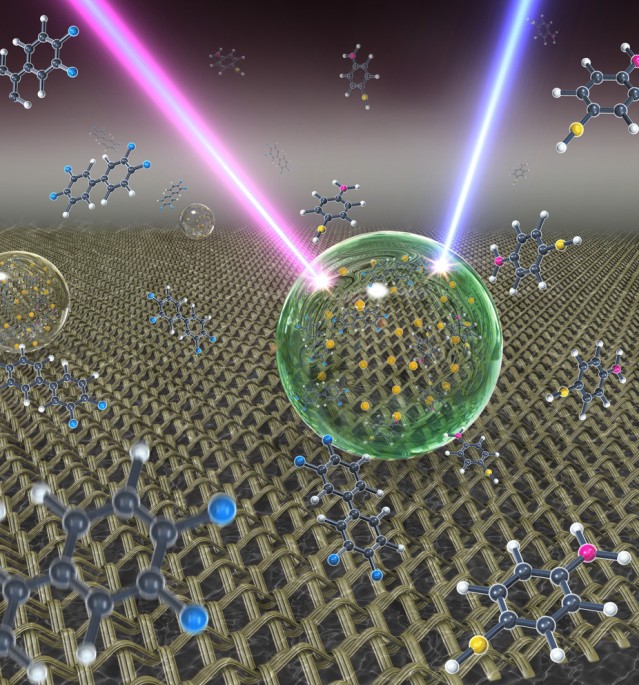Jan 13 2016
A team of researchers from Penn State have developed a new and unique technique that enables the detection of single molecules of biological and chemical species from solid, liquid and gaseous samples, based on the ultra sensitivity of the surface-enhanced Raman scattering (SERS) with a slippery surface invented by Penn State. The researchers believe that the new technology would pave the way for various applications in the field of analytical chemistry, molecular diagnostics, environmental monitoring and national security.
 Artistic illustration showing an ultrasensitive detection platform termed slippery liquid infused porous surface-enhanced Raman scattering (SLIPSERS). In this platform, an aqueous or oil droplet containing gold nanoparticles and captured analytes is allowed to evaporate on a slippery substrate, leading to the formation of a highly compact nanoparticle aggregate for surface enhanced Raman scattering (SERS) detection. (Image: Shikuan Yang, Birgitt Boschitsch Stogin, and Tak-Sing Wong/Penn State)
Artistic illustration showing an ultrasensitive detection platform termed slippery liquid infused porous surface-enhanced Raman scattering (SLIPSERS). In this platform, an aqueous or oil droplet containing gold nanoparticles and captured analytes is allowed to evaporate on a slippery substrate, leading to the formation of a highly compact nanoparticle aggregate for surface enhanced Raman scattering (SERS) detection. (Image: Shikuan Yang, Birgitt Boschitsch Stogin, and Tak-Sing Wong/Penn State)
Tak-Sing Wong, assistant professor of mechanical engineering and the Wormley Family Early Career Professor in Engineering, was the leader of the research team. The new technique combines the advantages of SERS and Wong's slippery liquid-infused porous surfaces (SLIPS), giving it the name SLIPSERS. The Asian pitcher plant inspired the development of SLIPS.
We have been trying to develop a sensor platform that allows us to detect chemicals or biomolecules at a single-molecule level whether they are dispersed in air, liquid phase, or bound to a solid. Being able to identify a single molecule is already pretty difficult. Being able to detect those molecules in all three phases, that is really challenging.
Tak-Sing Wong, Assistant Professor of Mechanical Engineering
Postdoctoral fellow Shikuan Yang, a specialist in the SERS technique, helped Wong to combine the SLIPS and SERS techniques into a single process. Their discovery was presented online in the Proceedings of the National Academy of Sciences on December 31, 2015.
Raman spectroscopy is a popular technique, capable of performing material analysis in liquids where a laser light interacts with the molecules in the vibrational state. The frequency of the photons in the laser beam is shifted up or down based on the unique vibration found in only that type of molecule. It is necessary to improve the Raman signal to be used for detection, as typically it is very weak. In the 1970s researchers discovered a way to improve the Raman signal, this was done by chemically roughening the surface of a silver substrate and then the Raman signal would become more concentrated on the surface of the material absorbed on this silver. This led to development of SERS.
Developed by Wong as a postdoctoral researcher at Harvard, the SLIPS surface contains a coating of regular arrays of nanoscale posts that are infused with a liquid lubricant. This liquid lubricant can not mix with other liquids, it is trapped in the small spacing between the nanoposts, which produces a slippery, non-adherent surface.
The problem is that trying to find a few molecules in a liquid medium is like trying to find a needle in a haystack. But if we can develop a process to gradually shrink the size of this liquid volume, we can get a better signal. To do that we need a surface that allows the liquid to evaporate uniformly until it gets to the micro or nanoscale. Other surfaces can't do that, and that is where SLIPS comes in."
Tak-Sing Wong, Assistant Professor of Mechanical Engineering
A droplet of liquid on any normal surface will begin to shrink from the top down. Once it has evaporated, the target molecules are left in random configurations with weak signals. If all of the molecules can be clustered among the gold nanoparticles though, they will produce a very strong Raman signal.
First we need to use conductive nanoparticles, like gold. And then we have to assemble them so they make nanoscale gaps between the particles, called hot spots. The molecules bind to the gaps and a very strong electromagnetic field forms. If we have a laser with the right wavelength, the electrons will oscillate and a strong magnetic field will form in the gap area. This gives us a very strong signal.
Shikuan Yang, SERS Technique Specialist
In comparison to other techniques that allow researchers to concentrate molecules with water as the medium, SLIPS can be utilized with any organic liquid.
Our technique opens up larger possibilities for people to use other types of solvents to do single molecule SERS detection, such as environmental detection in soil samples. If you can only use water,that is very limiting."In biology, researchers might want to detect a single base-pair mismatch in DNA. Our platform will give them that sensitivity.
Shikuan Yang, SERS Technique Specialist
One of the next steps will be detecting biomarkers in blood for disease diagnosis at the very early stages of cancer while the disease is more easily treatable. "We have detected a common protein, but haven't detected cancer yet," Yang said.
Although the SLIPS technology is patented and licensed, the team has not sought patent protection on its SLIPSERS work.
We believe that offering this technology to the public will get it developed at a much faster pace. This is a powerful platform that we think many people will benefit from.
Tak-Sing Wong, Assistant Professor of Mechanical Engineering
Besides Wong and Yang, postdoctoral fellow Xianming Dai and graduate student Birgitt Boschitsch Stogin were also the other researchers involved in this study, which was carried out at the Materials Characterization Laboratory's sophisticated Raman spectroscopy lab, a facility of Penn State's Materials Research Institute.
The work was funded by the National Science Foundation.